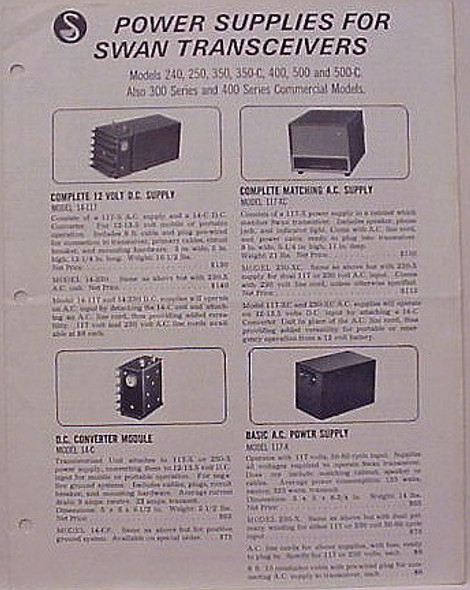Swan
Swan 117-C Power Supply with New Capacitors, for all Radios 350, 400, 500, 700 , 750 S/N M 132304
- MPN:
- 117-C
- Condition:
- Used
- Shipping:
- $45.00 (Fixed Shipping Cost)
Description
This Swan "Universal" 117C Power Supply, is compatible for all Radios like the 240, 250, 350, 400, 500, 700, and 750.
It is S/N M 132304.
This one is in Excellent condition and has been tested with a High Power transceiver and it worked with no apparent problems.
The original electrolytic capacitors have been replaced with modern black 105C capacitors.
The Cabinet is in great shape with only a few minor touchups
I am selling this Power supply as is as described.
Read all about it!
117C
This power supply operates from 117-V ac, was introduced in late 1964 as a replacement for the 117B for use
with the 350, 400 and later model transceivers, and was sold until the October 1965 time frame.
While the 117C model uses the same form-factor and sheet metal/chassis fabrication techniques as the 117AC, there are some notable differences. The speaker grill pattern was changed from the wider spaced hole matrix to the smaller, more dense matrix used in all subsequent models, the lower front panel paint was changed from the powder blue to a the darker gray, similar to that used on the 400/350 transceiver models, and the large round ventilation holes in the upper portion of the side cabinet were changed to large slotted holes extending from the upper side portion onto the case top. The sheet metal used in chassis and bracket construction was changed from the flimsy aluminum to steel, making it much more sturdy. The circuit design and component selection was also changed, with the multiple 100-μF HV and MV filter capacitors replaced by two can-type, multi-section electrolytic capacitors to clean up with point-to-point wiring used in the 117AC, two chokes were used in the MV supply, and a 4.7-Ω resistor, rather than the 15-Ω resistor, was in the relay supply, since the 117C is intended for use with the later 350/400 dual relay transceiver models.
While the 117C (and 117AC) cabinet is quite similar in design and styling to that used by the much more common 117XC that replaced it, the physical power supply configuration is significantly different from that model, in that the supply is not in a totally enclosed black-box, but has the power transformer exposed and directly
mounted on the chassis (as was done with the 117AC model) that has a footprint the same size as the 117XC cabinet. The ac power and output cables are attached directly to the rear chassis apron. Like the earlier 117B and later 117X-type power supplies, it will also power all 350, 400 series and later tube-design transceivers.
It includes a cabinet and loudspeaker like the 117XC, with a similar footprint and cabinet/front panel styling.However, the front panel may differ somewhat with a grid pattern with fewer and larger holes akin to those used in the 117AC, but it is still similar in overall design to the 117XC.
Like the 117AC and 117B, it also differs from the 117X in that it derives the MV from a center tap on the HV secondary, as opposed to a separate secondary winding used in the 117X, as can be readily seen by a comparison between the schematics shown in Figs. 3-5 or 3-6 and 3-7. The nominal +800 V is derived from a single winding,
rather than from the series connection of the +600 V (HV) rectifier and +275 V (MV) rectifier as is done in the 117X power supply. As noted above, the 117C model uses a dual-choke MV filter design – such a configuration can have a much higher no-load voltage than when under typical operational loading, so if troubleshooting without a transceiver connected, expect to see MV levels on the order of 380 V that will be drawn down during operation to about 278 V.
If this power supply is used with one of the earlier transceiver models (i.e. 240 or earlier), the bias supply voltage will be too high and it needs to be reduced with the simple modification to the bias output circuit. The relay series resistor is also too low and should be changed from 4.7 Ω to 15 Ω.






















